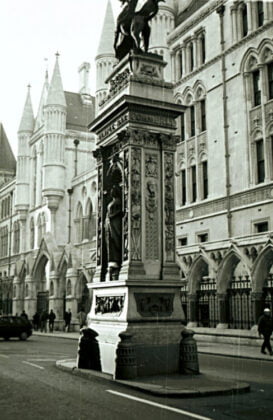No matter how you arrive at Two Temple place on the Victorian Embankment, you will come across many fine examples of London’s History, walking down Fleet Street from St Pauls Cathedral or using the Bus 4 from that direction towards Waterloo.
Passing the Iconic 1880 Horace Jones Temple Bar Memorial in the middle of the Strand, just before the Royal Courts of Justice. It lies around the original site of Temple bar, which itself has an interesting journey it was relocated out of London brick by brick and returned to Paternoster Square 2004
Keeping on the opposite side of the road to the Royal Courts of Justice still on The Strand turn left into Essex Street WC2 the River will be in front of you. You will see a large brick arch at the end of the road with a mysterious looking drop down, not for people with vertigo or mobility restrictions. It has a set of stone steps heading down towards what looks like the direction of the Thames.
Go under the arch and down the steps into Milford Lane WC2 (wiki have a photo of the back)….the building in front of you on the right with the leaded light windows in is the back and side of 2 Temple place. Walk around the front turn right onto Victoria Embankment and right into its gateway.
If the arch and the steps are not possible. Continue from the Stand and take the next very close road on the left after Essex St. Arundel St. Turn left at the end of this road and keep going along Victoria Embankment till you get to Temple place on the left. It’s usually got a billboard outside and its ornate decoration very easy to spot.
A unique stunning building.
It is interesting to visit just for the building’s exterior and interior. Notable Architecture was by Sir George Frampton RA, Nathaniel Hitch, Thomas Nicholls, William Silver Frith. In 1895 the building was built for William Waldorf Astor by John Loughborough Pearson. William Waldorf was the founder of the Waldorf Astoria Hotel in New York USA. It was Known as Astor Estate, built out of Portland stone in the Elizabethan style. A wonderful weather vane that celebrates caravel Santa Maria from when America was discovered by Columbus. John Jacob Astor William’s ancestry had notable links between the USA and Europe. The French Renaissance style was used inside by John Dibblee Crace who also decorated Astor’s home in Cliveden.
Astor’s favourite book “The three musketeers” provided a theme for the sculpted figurines in wood that appear on the wooden bannisters of the staircase. The Great Hall has a gilded Frieze of characters that crossed historic and fictional notability.
1919-1928 The Building changed owner and name Sun of Canada house. 1928 it was then called Incorporated Accountants Hall. 1929 saw it become Head Office of the Society by H.R.H The Duke and Duchess of York. In 1944 it was bombed and damaged a bit in ww2. The company Smith & Nephew took it over the start of the 60s.
The Bulldog trust took over the building in 2011. It’s the first London venue to display publicly owned are from Uk regional collections. The Bulldog trust assists in a wide range of charitable causes.
There is a WW1 Memorial stone inside. The floor is also made from Marble, onyx, jasper porphyry ( large crystals in igneous rock). In a pattern geometrically laid out known as opus alexandrinum.
Wooden staircase Mahogany carvings of the three musketeers characters. Ebony wood pillars
Stained glass ceiling and windows Clayton and Bell one of the windows is called A Swiss summer landscape
The Venue is free to visit. They offer items about the exhibition to purchase and loan guides for your visit. They also run paid talks/tours of the building/exhibitions. A friends scheme. Venue hire, events. A café, A shop. They have a downloadable program on their website or a printed one to take away.
We have found their door greeting always so consistent, inclusive and welcoming.







